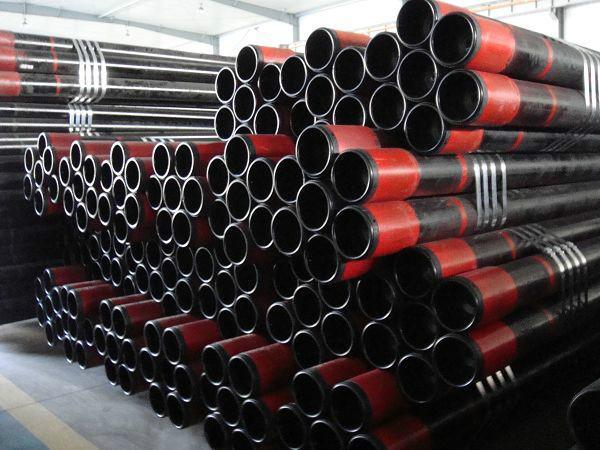Oil Country Tubular Goods (OCTG) and Line Pipe are collectively known as Oil Specialized Pipe. Petroleum Specialized Pipe is actually a deep-processed product of steel pipe, including Oil Country Tubular Goods (OCTG) and Oil & Gas Transportation Pipe (OGTP).
Drill pipes,
casing pipe, tubing, drill collars, square drill pipes, etc. are collectively called oil well specialized pipes.
1. What are the widely used production and inspection standards for oil-specific pipes at home and abroad?
The service conditions of petroleum pipe are quite severe, and its quality requirements are much stricter than that of general seamless pipe, which must be produced and inspected according to specialized standards or technical conditions. At present, the production and inspection standards widely used at home and abroad for oil-specific pipes are mainly based on the American Petroleum Institute (API) standards. API SPEC5 CT standard is adopted for casing and tubing, API SPEC5 standard is adopted for drill pipe, and API SPEC7 standard is adopted for drill pipe joints.

2. What are the types of non-API tubing and casing used at home and abroad to meet the special geological working conditions of oilfields?
In addition to API standard casing, non-API casing used to meet the special geological working conditions of oilfields has been researched and developed at home and abroad, including: ultra-high-strength tubing and casing used in deep wells; high crush-resistant casing; antihydrogen sulfide stress-corrosion tubing and casing used in hydrogen sulfide-containing oil and gas wells; high-strength tubing and casing used in cryogenic oil and gas wells; tubing and casing used in corrosive environments that contain only carbon dioxide and chlorine ions but almost no Hydrogen sulfide corrosive environment for the use of tubing, casing; for hydrogen sulfide, carbon dioxide and chloride ions coexist in a strong corrosive environment for the use of tubing, casing.
3. What are the roles of tubing and casing in oil wells? Which casing can be categorized according to the different roles?
In oilfield drilling and production operations, "casing" refers to the tubing used as a liner in the borehole to prevent the well wall from flowing or caving in. It is a permanent part of the well and is cemented to the bottom of the casing. The cement is sometimes returned to the surface. Most casing has an outside diameter of 114.3mm or larger sizes. The innermost tube in the well is called tubing. Downhole fluids are sent to the surface through the tubing, which can be separated from the casing by a production separator.The tubing is often pumped out of the well and sometimes needs to be replaced. Most tubing is 114.3mm OD or smaller.
The drilling environment often requires several layers of casing to achieve the desired total well depth. Each layer of casing is further categorized according to its role:
(1) Conduit. This is the outermost layer of the well, and its main purpose is to reinforce the walls of the well to prevent the surface gravel layer and uncemented rock from falling into the well.
(2) Structural pipe. Between the conduit and the surface tubing, the purpose of this layer of casing includes addressing recurrent leakage or well collapse and minimizing shallow gas surges.
(3) Surface casing. The purpose of the lower surface casing is multiple and includes isolating the freshwater layer to prevent collapse and leakage, isolating weak sections of the layer that cannot withstand the back pressure exerted as a result of well surge control, providing for the installation of a blowout preventer, and supporting the weight of all layers of casing smaller than the surface casing.
(4) Intermediate casing. The main use is because high pressure layers will be encountered in drilling, and high density drilling fluid is needed to control the abnormally high pressure, and the shallower weak strata must be protected against leakage or stuck drilling. In some special cases, intermediate casing is also used to isolate salt formations or expansive and collapse-prone shale formations.
(5) Lining pipe. The liner pipe serves the same purpose as the intermediate casing. The liner pipe extends upward from the bottom of the well into the intermediate casing, but does not extend to the surface. Liner tubing is often used to save money by not having to extend the tubing column to the surface but still achieve the purpose of controlling pressure and fracture gradients.
(6) Production casing. Also known as formation casing. The role of this column is: to separate the production layer from other formations, forming a given diameter and can go down to the production layer of the working wellbore, to protect the production tubing and equipment.
(7) Recovery tubing column. The liner is also commonly used as part of the production casing rather than as a separate column of pipe from the surface down to the production formation. The liner can be returned to the surface with an appropriate amount of tubing from the top of the liner.
4. What are the steel grades of tubing and casing and what do they mean?
In the API SPEC5CT standard, the steel grade of casing and tubing indicates its yield strength and some special characteristics. Steel grade designations are usually expressed as 1 letter and 2 or 3 numbers, such as N80. in most cases, the further down the alphabet the letters go, the greater the yield strength of the pipe. For example, N80 grade steel has a greater yield strength than J55.
The numerical notation is determined by the minimum yield strength of the pipe expressed in thousands of pounds per square inch. For example, the minimum yield strength of N80 steel grade is 550Mpa.
API SPEC5 CT standard lists the following casing steel grades: H40, J55, K55, N80, M65, L80, C90, C95, T59, P110, Q125; casing steel grades are: H40, J55, N80, L80, C90, T59, P110.
Go here to learn more about " Difference between drill pipe and drill collar"


